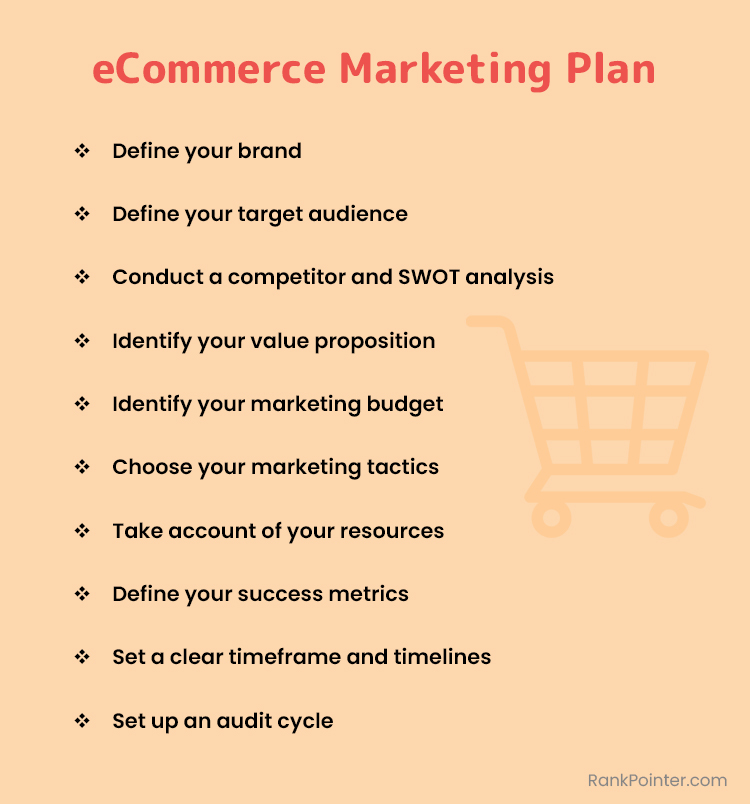Business owners having an online store can use this article to develop an eCommerce marketing plan to attract more customers and increase their sales.
You might be recently opened an online store for your company. Your work is not yet finished, regardless of whether you converted your offline company to an online one or used the new eCommerce opportunity to pursue your passion.
Time to roll up your sleeves and prepare to learn about modern marketing.
Everyone talks about being active on social media to reach their audience, but we believe that choosing the correct platform is much more important.
How do you create an eCommerce marketing plan?
The steps in developing a marketing plan for your online store are given below.

1. Define your brand
Firstly, you must clearly state in paper what your brand stands for. This includes, among other things, your logo, value proposition, vision, and business story. You must have this ready in order to use effective storytelling in your eCommerce marketing plan and ensure consistency in the positioning of your brand using various channels. A digital marketing company will study your brand identity and brand reputation to come up with the ideal eCommerce marketing plan.
2. Define your target audience
Your target audience, or the group of people your marketing methods will be aimed at, is the next element your eCommerce marketing plan has to specify.
This involves determining your ideal customer profile (ICP), which is the description of the highly specific member of your target audience that you want to buy from you. Your target audience is the general demographics of all the people you can sell to.
3. Conduct a competitor and SWOT analysis
You must conduct a scenario analysis before you even brainstorm the marketing strategies you’d like to employ to reach your target demographic. This entails doing in-depth SWOT and competitive analyses.
This will give you knowledge of where you stand right now, how your rivals have been promoting their goods to consumers with comparable interests, and the strategies you might need to employ as well.
4. Identify your value proposition
Using the study you did above, you may learn more about what makes your brand unique. From the features of your product or service to the discounts and offers you can provide, the extra benefits you can provide (free or discounted shipping), the cost of the products, and similar things.
5. Identify your marketing budget
The next step after settling on your product’s prices and unique selling proposition is to calculate your marketing budget.
Keep in mind that your marketing budget should not be included in the price of producing or outsourcing your products, shipping, providing discounts, or your revenues.
6. Choose your marketing tactics
Businesses must adapt to the rapidly changing digital landscape in order to stay competitive.
You might choose to market your business differently, though, depending on who your target market is and how much money you have to spend.
For instance, adopting networks like Instagram to reach a younger audience can help you develop naturally. You may need to set aside more money for well-targeted marketing and networking if your target market is older and you need to sell on LinkedIn.
To do this, pick a marketing strategy from the list below:
- Search engine optimization (SEO)
- Email marketing
- Social media marketing
- Content marketing
- Facebook marketing
- Instagram marketing
Social media marketing and SEO services are necessary if your business wants to reach a wide group of audience.
7. Take account of your resources
The following stage is to decide who or how you’ll implement the techniques once you’ve selected them and established a clear marketing budget.
This entails investigating the resources you have at your disposal, both in terms of human resources and the amount of time needed for each technique.
Remember that you don’t have to roll out all of your marketing initiatives at once. To optimize the time, effort, and human resources allotted for the same, you might start slowly with what is more likely to assist you in reaching your target consumers.
8. Define your success metrics
The second stage is to consider what you hope to accomplish with the marketing strategies you select.
You must be able to gauge any marketing strategy’s effect on your company before you begin using it.
For instance, social media may be very effective in the first few months to create some brand awareness. However, paid advertising on the same could help you produce actual leads and purchases.
Using eCommerce analytics tools and your store dashboard, you have access to a lot of data. It’s crucial to map the correct numbers, though.
You can learn more from the article about Ecommerce Marketing Analytics: How to Measure the Success of Your Marketing Campaigns?
9. Set a clear timeframe and timelines
The duration you expect to need to complete your goals should also be specified in your eCommerce marketing plan.
An eCommerce marketing plan could be created for a duration of three months, six months, or a full year. But be sure to establish precise deadlines and timetables for each marketing strategy you choose.
If you want to use Instagram for marketing, for example, set a goal and a deadline for yourself.
By doing this, you may more effectively control your marketing expenses and resource allocation.
10. Set up an audit cycle
The final phase in your eCommerce marketing strategy is crucial.
A marketing plan shouldn’t be developed as a one-time task.
You must constantly assess how successfully you are following the plan, how various marketing methods affect the expansion of your organization, and what you need to do better.
Establish a clear review/audit cycle to help you identify opportunities and potential resource drains.
You can set up a quarterly, half-yearly, or annual audit depending on the products your business sells and the level of competition.
Useful Article: SEO Audit: A Complete Guide
How to Develop an eCommerce Marketing Plan to Boost Sales – Conclusion
Before introducing your brand to your target audience, it’s critical to have a marketing strategy in place.
When trends are changing daily, having an eCommerce marketing plan will help you think more effectively and keep your efforts in line.
Frequently Asked Questions
Why is having an eCommerce marketing plan important for my online store?
An eCommerce marketing plan is essential because it provides a structured approach to attract more customers and increase sales. It helps you define your brand, target audience, marketing tactics, and success metrics, ensuring that your efforts are aligned with your business goals.
What role does SEO play in an eCommerce marketing plan?
eCommerce SEO is a crucial component of the marketing plan. It involves optimizing your online store’s content and structure to rank higher in search engine results, ultimately driving organic traffic to your website.
Related Article: Top 10 eCommerce SEO Tips to Boost Organic Traffic of Your Store
Which marketing tactics can I choose for my eCommerce marketing plan?
The choice of marketing tactics depends on your target market and available budget. Some common tactics include search engine optimization (SEO), email marketing, social media marketing, content marketing, and paid advertising on platforms like Facebook and Instagram.
How do I determine my eCommerce marketing budget?
Your marketing budget should be calculated separately from the costs of producing or outsourcing products, shipping, and other expenses. It should be based on your financial capabilities and the marketing strategies you plan to implement.


